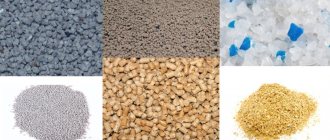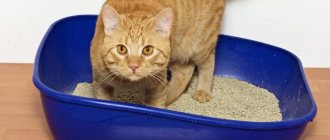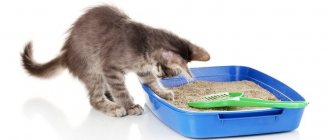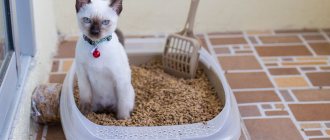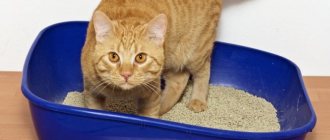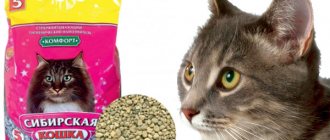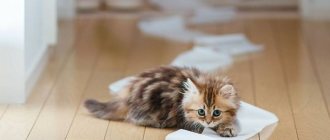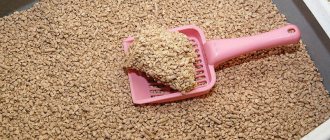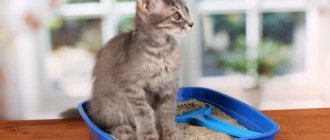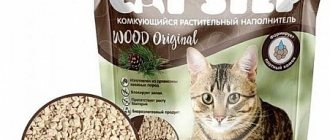Pet owners know firsthand: their beloved pets bring both joy and a certain amount of trouble! However, store shelves offer a huge selection of products that can make caring for your pet easier. The list of these products includes cat litter. Choosing a litter tray, as you know, does not cause any difficulties for anyone, and litters are presented in different versions. They differ in manufacturers, costs and materials of manufacture. Bentonite litter tray is one popular option. It contains exclusively natural ingredients. If you want to learn more about bentonite litter, read this article!
Features of bentonite filler
Bentonite litter is suitable for all cats. The composition contains natural clay (environmentally friendly material). Available in the form of small granules, usually gray or beige. The clay in this filler is hygroscopic; when it reacts with cat urine, the granules form a lump.
Wet filler can be easily removed by using a scoop. Some of the granules remain in the tray, suitable for further use. As necessary, add new bentonite filler to the recommended layer thickness. But when caring for your pet, it is important to take into account that bentonite litter is not thrown into the toilet. It is recommended to dispose of it in a bag that is tightly closed.
Brands of toilet mixtures
Sand of the “Pi-Pi Bent Classic” brand has these properties.
Many types of bentonite toilet composition have been developed. They differ in the size of the granules. Bentonite can be neutral or have an easily perceptible herbal odor. In addition, a filler has been produced that contains bentonite clay and wood inclusions. Some of the most common toilet mixtures are the following brands:
- Biokat's;
- Fussie Cat;
- Pi-Pi-Bent Classic;
- "Sea Sea Cat";
- "Clean paws";
- PrettyCat.
Owners select a filler that is convenient for cleaning. It is also important that the cat likes it, because often the animal may avoid going to the toilet due to the size of the granules or their composition. The safety of the components is also considered important. It is possible for your pet to develop allergic reactions, as some fillers contain allergens. They can harm your pet's body.
Types of Bentonite Fillers
Care products are classified by granule size and are small, medium and large. Cat owners often buy litter with small granules because it is used more economically. But the disadvantage of the product is that it can stick to the pet’s paws, and it will carry it around the rooms.
Certain sizes of granules may not be suitable for a cat, which is also worth considering. The pet subconsciously compares the granules to the ground, so it perceives small ones better. Bentonite filler can be flavored or without a special smell. Fragrance granules neutralize unpleasant odors; they can be said to act as an air freshener.
Bentonite litter with the scent of lavender and baby powder is popular. However, before you buy such a product, you must take into account that not every cat likes it! It is important to remember: animals perceive odors differently.
The mixture containing bentonite clay differs in color. This is due to the natural origin of the material. The shade of the filler largely depends on the conditions under which the clay was mined and formed, as well as on the presence of natural impurities in the composition of the product.
Properties
| Index | Standard values |
| Color | white with brown or gray tint |
| Compound | oxides of silicon, aluminum, impurities oxides of potassium, calcium, sodium, iron, magnesium and others; Al2O3 • 4SiO2 • nH2O |
| Appearance | powder, granules |
| Smell | absent |
| Solubility | insoluble in all basic liquids (water, ethanol, ether, acids, alkalis) |
| Main substance content | SiO2 no less than 57%, Al2O3 no less than 13% |
| Taste | absent |
| Density | from 2.66 to 2.84 g/cm3 |
| Other | high hydrophilicity, swells 16 times when hydrated; plastic; resistant to chemical acids; has the ability to self-disperse |
Why should you buy bentonite litter?
The filler is affordable, but it has other advantages:
- Bentonite litter does not smell or has a slight pleasant aroma, so the pet quickly gets used to it.
- Availability, available in almost every store.
- The filler is presented in a wide range, everyone can choose the most optimal option.
- Excellent absorbency rate.
- Some types of filler contain additional granules that neutralize unpleasant odors, for example, activated carbon.
- The product prevents the development of bacteria and is safe for people and animals.
- The filler has an excellent structure that resembles sand or earth to your pet.
- One of the main advantages is economical use (due to the fact that clumping occurs). A 5 liter bag will last up to 4 weeks.
Bentonite filler retains unpleasant odors and prevents them from spreading throughout the house. When a cat buries waste products, the specific smell does not spread due to the fact that the granules lock the smell inside the lump.
The filler differs not only in structure, but also in cost. There are cheaper goods, and there are more expensive ones. Bentonite filler is easy to use, but its key advantage is safety.
conclusions
So, based on the above, we can conclude what kind of cat litter can be flushed down the toilet?
- The sewer can only “absorb” wood, paper and vegetable fillers, and it is not recommended to empty the entire tray at once - you need to wash it off in small batches.
- Can clumping litter be flushed down the toilet? Mineral and silica gel are clumping types. Mineral - can be washed off, but only a small portion with feces. But silica gel - absolutely not, just throw it in the garbage chute.
Usually the packaging contains the manufacturer's recommendations for disposal of this product. If you follow these rules, you will not face any blockages.
Share on social media networks:
The best option for cat litter!
Bentonite based filler is a high quality product. Bentonite is a natural material used for various purposes. Bentonite-based tray filler is recognized as the best. Judging by the reviews, it is very easy to use. After your pet goes to the toilet, you just need to remove the lumps that have formed. The remaining filler can be used further.
Please note that the product should not be flushed down the toilet. It must be carefully placed in a bag. It is important to remove the formed lumps in time, otherwise they will emit a not too strong, but unpleasant odor. Bentonite retains moisture and unpleasant odors due to its special properties. But the pet owner should always monitor his toilet, then there will be no problems! To avoid the spread of odor, lumps must be removed in a timely manner. With bentonite filler you will save valuable time and money!
We found out: bentonite filler has many advantages. The important thing is that it reminds the cat of sand or dirt. To bring the toilet conditions closer to natural ones, you need to choose the right filler thickness. It is desirable that it vary from 5 to 7 cm, then lumps will form faster.
Cat breeders have appreciated the benefits of bentonite litter. It is worth noting that bentonite is safe for kittens, which by their nature are more delicate, sensitive, and fragile. There are 2 types of bentonite: sodium and calcium. Sodium is often used in the production process. The acidity level of such clay is more than 7 units, which means it absorbs moisture better and promotes clumping.
The product copes well with unpleasant odors and quickly neutralizes them. Bentonite is a unique natural material containing 70% montmorillonite (the component directly responsible for clumping). Bentonite clay is created by nature and is 100% suitable as cat litter. When the liquid reacts with it, the clay increases in size. And lumps form instantly.
Benefits and harms
Additive E 558 is safe for health. Only inhalation of bentonite powder dust can cause relative harm (irritation of the upper respiratory tract, cough).
Bentonite benefits the body as an effective sorbent . The substance cleanses the intestines, removes toxins, and improves overall well-being.
Calcium silicate (E552) is often used in the production of salt to prevent caking and clumping.
What is magnesium hydroxide and where is it used? We talked about this in detail here.
Currently, sandalwood is not used as a dietary supplement. Why - read our article.
Bentonite fillers CAT STEP
The quality of “CAT STEP” brand products is always at the highest level! This means that it allows you to satisfy the needs of even capricious cats and cats, as well as their owners. CAT STEP is an affordable, practical filler that has earned a lot of positive reviews!
- absorbs well and instantly forms a lump;
- destroys all unpleasant odors;
- does not stick to the cat's fur and paws;
- does not emit odors and dust that are repulsive to animals;
- non-toxic and does not cause allergies;
- easy to clean and use;
- takes care of your budget.
Main manufacturers
In Russia, the production of the E 558 additive is carried out by the Bentonite Company LLC holding, which includes the following enterprises:
- LLC "Bentonite Khakassia" (city of Chernogorsk);
- LLC "Bentonite Kurgana";
- JV "AzRosPromInvest" (Azerbaijan);
- Glinopererabotka LLC (Bryansk) produces granules for cat litter.
Leading global manufacturers:
- Bassermann minerals GmbH & Co.KG (Germany);
- Qualimet GmbH (Switzerland);
- Pointner & Rothschädl GesmbH (Austria).
Interesting fact! The development of bentonite deposits raises concerns among environmentalists: the quarry method of extracting the mineral destroys vegetation and disrupts the biological balance. The German company Gimborn (the company produces cat litter) came up with an interesting way out of the situation. Employees regularly plant hundreds of trees in the sites of already developed quarries.
Application
Additive E 558 is approved for use in the food industry as an emulsifier, carrier, drying agent, and anti-caking agent. The substance is included in the production technology of fat-and-oil and starch products.
The high adsorbing properties of bentonite, environmental friendliness and safety for health have made it possible to widely use the product for winemaking needs (OST 18-49-71).
Emulsifier E 558 is used:
- for clarification and purification of white grape must from waste yeast, tartar and other sediments - the causes of the formation of protein turbidity;
- for stabilization of wine materials, including for the production of champagne and sparkling wines;
- for clarification of fruit and berry juices.
The price you pay for convenience
But this convenience actually comes at a cost.
1. Most clay litters contain silicon dioxide (in other words, silica or SiO2) - the dust you can see and inhale when you pour litter or clean your cat's litter box. This is the same dust your pet breathes when it buries its waste. But what is most dangerous is silica when inhaled
is a carcinogen! [3]
2. Most clay fillers consist of alkaline bentonites (otherwise known as sodium bentonite or sodium bentonite) - this is a mineral that has a high swelling ability and is responsible for the formation of lumps when the filler gets wet. It can also expand to up to 20 times [1] its original volume and forms the same clumps you see in cat litter inside your cat when she licks the litter from her paws.
3. Again, most clay fillers also smell very strongly of perfumes - odor eliminators. You probably know the moment when, while pouring litter into a litter box or cleaning up after your pet, you are simply suffocated by the choking smell (and even taste it)? Admit it – you’re even trying not to breathe! Obviously, this is a constant source of irritation not only for you. Why? If the smell of litter has such an effect on a person, just imagine what a cat feels, whose sense of smell is several times stronger! Additionally, properly deodorized cat litter should not smell like flower poop, it should not smell like anything at all.
4. For the environment, clay filler is a real disaster. According to the Land Management Committee (USA), more than 3.6 million tons of harmful substances end up in landfills every year. And, worst of all, these substances are absolutely non-biodegradable! This means that your cat's mummified poop will be on this earth longer than you or I (and several more generations of people like you and me). A little scary, isn't it?
